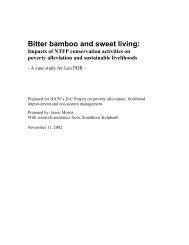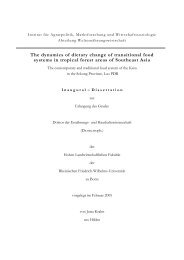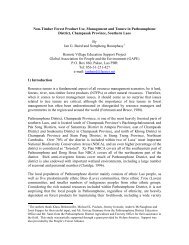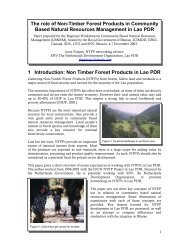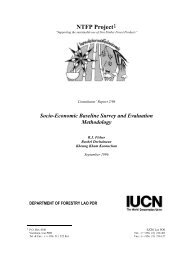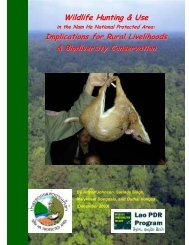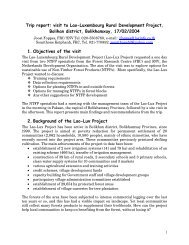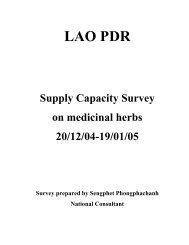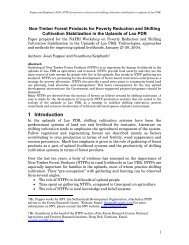Create successful ePaper yourself
Turn your PDF publications into a flip-book with our unique Google optimized e-Paper software.
2 METHODS<br />
The main methods used by the team bel<strong>on</strong>g to what has comm<strong>on</strong>ly become known as Rapid<br />
Rural Appraisal (RRA) methods. RRA methods are a better alternative to collect informati<strong>on</strong><br />
for rural development than c<strong>on</strong>venti<strong>on</strong>al approaches, such as questi<strong>on</strong>naire surveys. RRA<br />
methods provide relevant informati<strong>on</strong> timely and are more cost-effective. Local knowledge<br />
has great validity for rural development planning. RRA methods make this knowledge<br />
available to outsiders and allows local people to be involved in project planning, using their<br />
own terminology (NTFP Project, 1996). In this study, the following RRA tools were used:<br />
1 building rapport<br />
2 semi-structured interviews with key informants, cross checking<br />
3 structured group meetings<br />
4 participatory group sketch mapping<br />
5 listing and ranking of NTFP’s<br />
6 ranking of income and expenditure<br />
7 wealth ranking<br />
8 forest walks, rapid forest inventories<br />
9 simple family interview questi<strong>on</strong>naires<br />
2.1 Building rapport<br />
Good RRA work depends heavily <strong>on</strong> appropriate behaviour and attitude of project staff. Such<br />
behaviour includes:<br />
• building rapport with men and women, rich and poor, young and old, etc.;<br />
• being friendly, interested, culturally sensitive, relaxed, open;<br />
• listening and probing;<br />
• taking advantage of local events rather than staging events and activities;<br />
• engaging in c<strong>on</strong>versati<strong>on</strong>s that have a two way exchange of informati<strong>on</strong>;<br />
• being patient but proceeding at moderate pace;<br />
• seeking views of weaker, less powerful groups;<br />
• sharing informati<strong>on</strong>;<br />
• learning from people, not lecturing;<br />
• being nice to people, and avoid placing them in situati<strong>on</strong>s in which they feel<br />
uncomfortable;<br />
• giving people time to communicate an c<strong>on</strong>sider ideas;<br />
• scheduling RRA activities so that they fit in with seas<strong>on</strong>al and daily routines of people.<br />
Another essential point of our method was to stay overnight in the village. This not <strong>on</strong>ly<br />
allowed us to do most of our group activities when most people were available, i.e. in the<br />
evening, but it also gave us an opportunity to build rapport. We would cook our own meals<br />
but invite villagers to join our meals. Also we could catch up with people in the morning<br />
before they went to their fields. Staying in the village also allowed us to calibrate local<br />
product measures.



